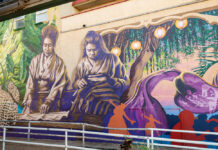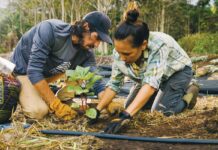About 15 years ago, John Lind, then vice president of the Kipahulu Community Association, offered the Kalena land for a school the association wanted to start so young children wouldn’t have to ride a school bus into Hana town each day.
As it happened, the school ended up elsewhere, but eventually this connection resulted in the construction of a kitchen that will benefit both groups—the native Hawaiians of Pohaku, whose ancestors have lived in Kipahulu for generations, and the newcomers from other parts of the world who bought pieces of this verdant land hoping to live a rural, agricultural lifestyle.
“We wanted a certified kitchen a long time ago,” says Tweetie Lind. The Linds and Minn were especially interested in finding a place to process taro, because through another organization, the Kipahulu ‘Ohana, they operate the Kapahu Living Farm on Haleakala National Park land mauka (inland) of the Pools at ‘Ohe‘o. The ‘Ohana has cleared and replanted about two dozen ancient taro patches, or lo‘i.
Besides taro, Lind says, there are plentiful supplies of bamboo shoots, ‘ulu (breadfruit), mango, guavas, and coconuts in Kipahulu, but nowhere to process these raw materials for retail sale. Even products like dehydrated bananas and papayas cannot legally be sold anywhere but in a certified kitchen meeting Department of Health standards for commercial use.
The first funds for the kitchen project came in 1996, when Lisa Hamilton, then on the board of the Kipahulu Community Association, was in town for a County Council meeting, and on impulse asked for a $10,000 grant for a water-catchment system. That funding went to make the first portion of a roof to collect rainwater. Then “it really kind of evolved over time,” Hamilton recalls. “It became obvious we weren’t just talking about washing taro on a concrete floor. We wanted to go another step in adding shelf life and value.”





